Click on images to enlarge
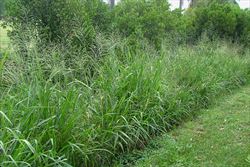
infestation along a waterway (Photo: Sheldon Navie)
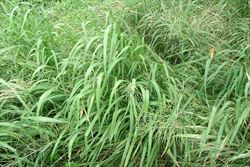
habit (Photo: Sheldon Navie)

habit in flower (Photo: Sheldon Navie)
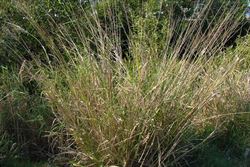
habit with mature seed-heads in the dry season (Photo: Sheldon Navie)
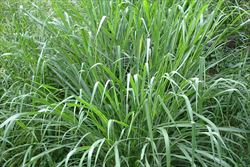
very large leaves (Photo: Sheldon Navie)
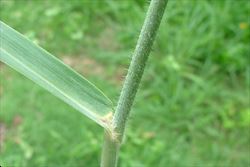
close-up of stem and base of leaf blade (Photo: Sheldon Navie)

close-up of leaf blade showing whitish midrib and scabrous margins (Photo: Sheldon Navie)
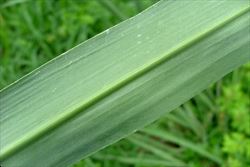
close-up of leaf underside (Photo: Sheldon Navie)

large and much-branched seed-head (Photo: Sheldon Navie)
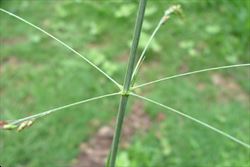
base of seed-head showing whorl of branches (Photo: Sheldon Navie)
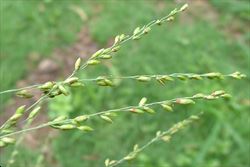
close-up of flower spikelets (Photo: Sheldon Navie)

close-up of seeds (Photo: Steve Hurst at USDA PLANTS Database)

comparison of the relative size of green panic (Megathyrsus maximus var. pubiglumis), on the left, and Guinea grass (Megathyrsus maximus var. maximus), on the right (Photo: Sheldon Navie)
Scientific Name
Megathyrsus maximus (Jacq.) B.K. Simon & S.W.L. Jacobs var. maximus
Synonyms
Panicum maximum Jacq. var. maximum
Urochloa maxima (Jacq.) R.D. Webster var. maxima
Family
Gramineae (South Australia)
Poaceae (Queensland, New South Wales, the ACT, Victoria, Tasmania, Western Australia and the Northern Territory)
Common Names
brown top buffel grass, buffalo grass, buffalograss, bush buffalo grass, colonial grass, common buffalo grass, Guinea grass, guineagrass, purple top buffalo grass, purple top buffalograss, Tanganyika grass
Origin
Native to Africa.
Cultivation
Guinea grass (Megathyrsus maximus var. maximus) has been cultivated as a pasture grass in the warmer regions of Australia.
Naturalised Distribution
Widely naturalised in northern and eastern Australia (i.e. in northern and eastern Queensland, in eastern New South Wales, in the coastal districts of northern Western Australia and in the northern parts of the Northern Territory). Also recorded in south-western Western Australia, the southern parts of the Northern Territory, and on Norfolk Island.
Habitat
A very common and widespread weed of crops, orchards, vineyards, disturbed sites, roadsides, railways, footpaths, parks and gardens, bushland and riparian vegetation in the tropical, sub-tropical, warmer temperate and semi-arid regions of Australia.
Habit
A long-lived (i.e. perennial) grass with short underground stems (i.e. rhizomes) forming tufted clumps and aboveground stems that are usually upright (i.e. erect) in nature. Guinea grass (Panicum maximum var. maximum ) grows up to 3 m tall, but is usually about 2 m in height.
Distinguishing Features
- a large, clumping, long-lived grass growing up to 3 m tall.
- its long and narrow leaves are very large (up to 100 cm long and 3.5 cm wide).
- its large and much-branched seed-heads bear large numbers of small flower spikelets.
- the lowermost branches of its seed-heads are arranged in a cluster.
- its hairless flower spikelets are green or purplish in colour and are shed from the seed-head entire when mature.
Stems and Leaves
The stems may be branched and vary from being hairless (i.e. glabrous) to quite hairy (i.e. pilose).
The leaves consist of a sheath, which encloses the stem, and a spreading leaf blade. These long and narrow leaves are very large (15-100 cm long and 5-35 mm wide) with entire margins and pointed tips (i.e. acuminate apices). Like the stems, they can vary from being hairless (i.e. glabrous) to being quite hairy (i.e. pilose), but they are most commonly sparsely hairy (i.e. puberulent). The leaf blades are usually held flat and their margins are rough to touch (i.e. scabrous). Where the leaf sheath meets the leaf blade there is a small membranous structure topped with hairs (i.e. the ligule is a ciliate membrane).
Flowers and Fruit
The seed-heads (i.e. inflorescences) are loosely branched (i.e. open panicles) and 12-60 cm long. Their lowest branches are arranged in a cluster (i.e. whorl), while the branches further up the seed-head are variously arranged. The flower spikelets are small (3-4.5 mm long) and oval (i.e. elliptic) or oblong in shape. They are generally green in colour, but occasionally may be purplish or reddish in colour. These flower spikelets are hairless and have only one fertile floret. They are shed from the seed-head entire when mature.
Reproduction and Dispersal
This species reproduces mainly by seed, which are dispersed by animals, wind, water, vehicles, machinery. Seeds may also be spread in contaminated soil and agricultural produce (e.g. fodder or grain).
Environmental Impact
Guinea grass (Megathyrsus maximus var. maximus) is regarded as an environmental weed in Queensland, the Northern Territory and north-eastern New South Wales.
Other Impacts
This species is also a widespread weed of crops in northern Australia (e.g. plantation crops, vegetables, sown pastures, cotton, legumes, summer crops and brassica crops).
Legislation
Not declared or considered noxious by any state government authorities.
Management
For information on the management of this species see the following resources:
- the Biosecurity Queensland Fact Sheet on this species, which is available online at http://www.dpi.qld.gov.au.
Similar Species
Guinea grass (Megathyrsus maximus var. maximus) and green panic (Megathyrsus maximus var. pubiglumis) can be distinguished from each other by the following differences:
- Guinea grass (Megathyrsus maximus var. maximus) is a large and robust plant (1.8-3 m tall) with very large leaves and seed-heads. Its leaves are usually dark green in colour and its flower spikelets are hairless.
- green panic (Megathyrsus maximus var. pubiglumis) is a moderately-sized plant (usually about 1.5 m tall) with large leaves and seed-heads. Its leaves are usually paler green in colour and its flower spikelets are usually finely hairy.

